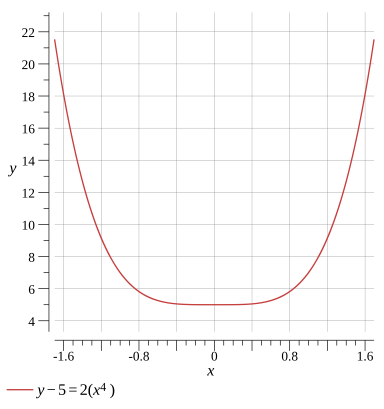Question
Function
Find the x-intercept/zero
Find the y-intercept
No x-intercept
Evaluate
y−5=2(x4)
To find the x-intercept,set y=0
0−5=2(x4)
Evaluate
0−5=2x4
Removing 0 doesn't change the value,so remove it from the expression
−5=2x4
Since the left-hand side is always negative,and the right-hand side is always positive or 0,the statement is false for any value of x
x∈/R
Solution
No x-intercept
Show Solution

Solve the equation
Solve for x
Solve for y
x=248y−40x=−248y−40
Evaluate
y−5=2x4
Swap the sides of the equation
2x4=y−5
Divide both sides
22x4=2y−5
Divide the numbers
x4=2y−5
Take the root of both sides of the equation and remember to use both positive and negative roots
x=±42y−5
Simplify the expression
More Steps


Evaluate
42y−5
To take a root of a fraction,take the root of the numerator and denominator separately
424y−5
Multiply by the Conjugate
42×4234y−5×423
Calculate
24y−5×423
Calculate
More Steps


Evaluate
4y−5×423
The product of roots with the same index is equal to the root of the product
4(y−5)×23
Calculate the product
48y−40
248y−40
x=±248y−40
Solution
x=248y−40x=−248y−40
Show Solution

Testing for symmetry
Testing for symmetry about the origin
Testing for symmetry about the x-axis
Testing for symmetry about the y-axis
Not symmetry with respect to the origin
Evaluate
y−5=2(x4)
Simplify the expression
y−5=2x4
To test if the graph of y−5=2x4 is symmetry with respect to the origin,substitute -x for x and -y for y
−y−5=2(−x)4
Evaluate
−y−5=2x4
Solution
Not symmetry with respect to the origin
Show Solution

Find the first derivative
Find the derivative with respect to x
Find the derivative with respect to y
dxdy=8x3
Calculate
y−5=2(x4)
Simplify the expression
y−5=2x4
Take the derivative of both sides
dxd(y−5)=dxd(2x4)
Calculate the derivative
More Steps


Evaluate
dxd(y−5)
Use differentiation rules
dxd(y)+dxd(−5)
Evaluate the derivative
More Steps


Evaluate
dxd(y)
Use differentiation rules
dyd(y)×dxdy
Use dxdxn=nxn−1 to find derivative
dxdy
dxdy+dxd(−5)
Use dxd(c)=0 to find derivative
dxdy+0
Evaluate
dxdy
dxdy=dxd(2x4)
Solution
More Steps


Evaluate
dxd(2x4)
Use differentiation rule dxd(cf(x))=c×dxd(f(x))
2×dxd(x4)
Use dxdxn=nxn−1 to find derivative
2×4x3
Multiply the terms
8x3
dxdy=8x3
Show Solution

Find the second derivative
Find the second derivative with respect to x
Find the second derivative with respect to y
dx2d2y=24x2
Calculate
y−5=2(x4)
Simplify the expression
y−5=2x4
Take the derivative of both sides
dxd(y−5)=dxd(2x4)
Calculate the derivative
More Steps


Evaluate
dxd(y−5)
Use differentiation rules
dxd(y)+dxd(−5)
Evaluate the derivative
More Steps


Evaluate
dxd(y)
Use differentiation rules
dyd(y)×dxdy
Use dxdxn=nxn−1 to find derivative
dxdy
dxdy+dxd(−5)
Use dxd(c)=0 to find derivative
dxdy+0
Evaluate
dxdy
dxdy=dxd(2x4)
Calculate the derivative
More Steps


Evaluate
dxd(2x4)
Use differentiation rule dxd(cf(x))=c×dxd(f(x))
2×dxd(x4)
Use dxdxn=nxn−1 to find derivative
2×4x3
Multiply the terms
8x3
dxdy=8x3
Take the derivative of both sides
dxd(dxdy)=dxd(8x3)
Calculate the derivative
dx2d2y=dxd(8x3)
Simplify
dx2d2y=8×dxd(x3)
Rewrite the expression
dx2d2y=8×3x2
Solution
dx2d2y=24x2
Show Solution

Graph
